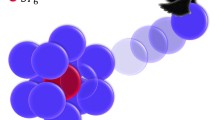Abstract
The reactivity of the C6F5X (X=F, Cl, Br, I) molecules following low energy (0–15 eV) electron attachment is studied in the gas phase under single collision conditions, free molecular clusters and condensed molecules by means of crossed beams and surface experiments. All four molecules exhibit a very prominent resonance for low energy electron attachment (<1 eV, attachment cross section >10−14 cm2). Under collision free conditions thermal electron capture generates long lived molecular parent anions C6F5X−*. Along the line Cl, Br, I dissociation into X−+C6F5 and X+C6F5-increasingly competes until for X=1 only chemical fragmentation is observed on the mass spectrometric time scale. In free molecular clusters chemical fragmentation is quantitatively quenched at low energies in favour of associative attachment yielding undissociated, relaxed ions (C6F5X)− n,n≥1. A further dissociative resonance at 6.5 eV in C6F5Cl is considerably enhanched in clusters. If these molecules are finally condensed on a solid surface, one observes a prominent Cl− desorption resonance at 6.5 eV. While the quantitative quenching of the chemical reactivity at low energies is due to the additional possibilities of energy dissipation under aggregation, the enhanched reactivity at 6.5 eV is interpreted by the conversion of a core excited open channel resonance in single molecules into a closed channel (Feshbach) resonance when it is coupled to environmental molecules.
Similar content being viewed by others
References
H. S. W. Massey, E. H. S. Bishop, H. B. Gilbody, Electronic and Ionic Impact Phenomena, 2rd Ed., Vol II, Oxford University Pres, London 1969.
T. D. Märk, Ionization of Molecules by Electron Impact, in Ref. 5..
E. C. Zipf, Dissociation of Molecules by Electron Impact, in Ref. 5..
L. G. Christophorou, Atomic and Molecular Radiation Physics, Wiley Interscience, London 1971.
L. G. Christophorou (Ed.), Electron-Molecule Interactions and Their Applications, Vols I and II, Academic Press, Orlando, FL, 1984.
E. Illenberger, J. Momigny, Gas Phase Molecular Ions: An Introduction to Elementary Processes Induced by Ionization, Steinkopff, Darmstadt, Springer, New York 1992.
T. Oster, A. Kühn, E. Illenberger. Intern. J. Mass Spectrom. Ion Proc., 89 (1989) 1.
O. Ingólfsson, F. Weik, E. Illenberger, Intern. J. Mass Spectrom. Ion Proc., 135 (1996) 1.
H. Shimamori, Y. Tatsumi, T. Sunagawa, J. Chem. Phys., 99 (1993) 7787.
A. Mann, F. Linder, J. Phys., B 25 (1992) 1621.
M. Allan, J. Electron Spectrosc. Relat. Phenom., 48 (1989) 219.
C. R. Herd, N. G. Adams, D. Smith, Intern. J. Mass Spectrom. Ion Proc., 87 (1989) 331.
W. E. Wentworth, T. Limero, E. C. M. Chen, J. Phys. Chem., 91 (1987) 241.
C. H. Moore, Atomic Energy Levels, Vol III, United States epartment of Commerce, NSRDS-NBS 35, Washington, DC.
L. Sanche, G. J. Schulz, J. Chem. Phys., 58 (1973) 479.
J. R. Frazier, L. G. Christophorou, J. G. Carter, H. C. Schweinler, J. Chem. Phys., 69 (1978) 3807.
O. Ingófsson, E. Illenberger, Intern. J. Mass Spectrom. Ion Proc., 149/50 (1995) 79.
M. B. Robin, Higher Excited States of Polyatomic Molecules, Vol III, Academic Press, Orlando, FL, 1985.
R. P. Frueholz, W. M. Flicker, O. A. Mosher, A. Kuppermann, J. Chem. Phys., 70 (1979) 3059.
P. Tegeder, L. Lehmann, O. Ingólfsson, E. Illenberger, Zeitschr. Phys. Chem., 195 (1996) 217.
G. W. Dillow, P. Kebarle, J. Am. Chem. Soc., 111 (1989) 5592.
F. Weik, E. Illenberger, J. Chem. Phys., 103 (1995) 1406.
T. Oster, O. Ingólfsson, T. Jaffke, M. Meinke, E. Illenberger, J. Chem. Phys., 99 (1993) 5141.
M. Meinke, L. Parenteau, P. Rowntree, L. Sanche, E. Illenberger, Chem. Phys. Lett., 205 (1993) 21.
Author information
Authors and Affiliations
Rights and permissions
About this article
Cite this article
Tegeder, P., Illenberger, E. Competition between reactivity and relaxation in free electron attachment to molecules. J Radioanal Nucl Chem 232, 53–62 (1998). https://doi.org/10.1007/BF02383712
Received:
Issue Date:
DOI: https://doi.org/10.1007/BF02383712




